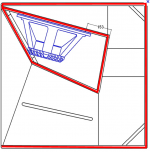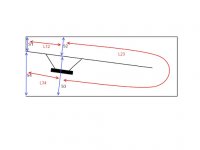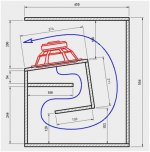I'm new to the speaker design game, although I have an engineering background. After reading what seemed like thousands of forum posts and asking a few questions, I was able to successfully design and build a small "sub" woofer to mate with a portable loudspeaker. My sub features a pair of 3" drivers and a pair of 3.5" passive radiators, and sounds good for the size & cost, although I'm still making measurements to see what I might tweak.
One thing that gnaws at me is the fact that I'm rolling off the drivers way below their potential max frequency. It feels like I'm throwing something away. This is not rooted in theory, just emotion! One alternative might be a bandpass design, which (if I could pull it off) would acoustically roll off those low mids and beyond. Is there any chance such a design could approach a pair of drivers + PRs in 2X the box in terms of low frequency extension and (hopefully) SPL?
What is the go-to resource for learning the physics behind a bandpass so I can perhaps dig in and get a little more "predictive" as opposed to just messing around within WinISD? I feel like I'm hunting in the dark. (That's because I *AM* hunting in the dark!) Thanks for any advice . . .
One thing that gnaws at me is the fact that I'm rolling off the drivers way below their potential max frequency. It feels like I'm throwing something away. This is not rooted in theory, just emotion! One alternative might be a bandpass design, which (if I could pull it off) would acoustically roll off those low mids and beyond. Is there any chance such a design could approach a pair of drivers + PRs in 2X the box in terms of low frequency extension and (hopefully) SPL?
What is the go-to resource for learning the physics behind a bandpass so I can perhaps dig in and get a little more "predictive" as opposed to just messing around within WinISD? I feel like I'm hunting in the dark. (That's because I *AM* hunting in the dark!) Thanks for any advice . . .
Assuming that your current subwoofer box is properly-designed, a properly-designed bandpass box will be larger, and roll off slower, but the rolloff will start at a higher frequency. The big advantage that a bandpass design brings is that the vent can filter out distortion, so the result can be a cleaner-sounding bass.
More information here - The Subwoofer DIY Page - Bandpass Systems
More information here - The Subwoofer DIY Page - Bandpass Systems
Hey. Just intall Hornresp and WinIsd or other programs and simulate some boxes and drivers.
Advantages can be size for SPL ratio, exploiting driver capabilities due to additional acoustical loading,less cone movement if the driver would exceed its maximum in lower order box.
Disadvantages: less cone movement for less coil cooling by motion, less supervision as you can't usually see and touch the cone/dustcap, group delay and other distortion issues as the sound is made by two air powered resonators.
Advantages can be size for SPL ratio, exploiting driver capabilities due to additional acoustical loading,less cone movement if the driver would exceed its maximum in lower order box.
Disadvantages: less cone movement for less coil cooling by motion, less supervision as you can't usually see and touch the cone/dustcap, group delay and other distortion issues as the sound is made by two air powered resonators.
My experience with bandpass is not so good. Although it goes deep, its group delay is too high, so it sounds muddy. Also the natural upper filter effect (low pass) does not work well, so it radiates a lot of unwanted frequencies, well beyond the linear region of the driver. But this is just my construction, might be wrong design.
Front Loaded Horns (BP4) and Tapped Horns (BP6) are bandpass designs.
FLH is a BP4 with a positive flared port.
TH is a BP6 where the whole enclosure is 2 positive, 2 straight, or 2 negative flare ports.
Pic 1 is a FLH. Pic 2 is a single fold TH. Pic 3 is a double fold TH.
Notice the single fold TH is only 7 panels like a ported, vented, or bass reflex box.
FLH is a BP4 with a positive flared port.
TH is a BP6 where the whole enclosure is 2 positive, 2 straight, or 2 negative flare ports.
Pic 1 is a FLH. Pic 2 is a single fold TH. Pic 3 is a double fold TH.
Notice the single fold TH is only 7 panels like a ported, vented, or bass reflex box.
Attachments
Last edited:
Great stuff, thanks. Regarding a delay for the high-pass: is this an effort to match group delay of the sub?
I'm looking at a WinISD model of a sub I built that sounds pretty good, and the group delay seems to be slightly positive (+ 12 ms) around F3, with a massive notch (-60 ms) maybe a half octave down. What's the sign convention here -- is a positive number a delay?
I'm looking at a WinISD model of a sub I built that sounds pretty good, and the group delay seems to be slightly positive (+ 12 ms) around F3, with a massive notch (-60 ms) maybe a half octave down. What's the sign convention here -- is a positive number a delay?
https://www.diyaudio.com/forums/sub...on-6th-bandpass-front-tuning.html#post5314595
I used words group delay controlled vented box, thats how i see it.
My friend Legis came to listen and he did not thumbs down these.
These where simulated with vituixcad by watching groupdelay, not so much frequency response.
Im not saying anyone should copy but works on my light use.
I used words group delay controlled vented box, thats how i see it.
My friend Legis came to listen and he did not thumbs down these.
These where simulated with vituixcad by watching groupdelay, not so much frequency response.
Im not saying anyone should copy but works on my light use.
- Status
- This old topic is closed. If you want to reopen this topic, contact a moderator using the "Report Post" button.
- Home
- Loudspeakers
- Subwoofers
- Benefits of bandpass


